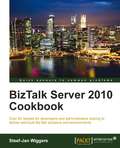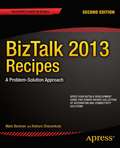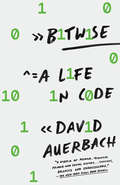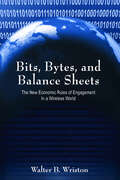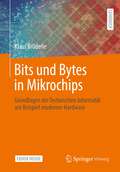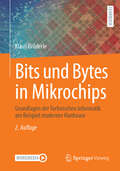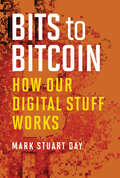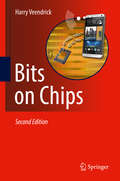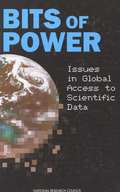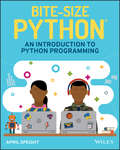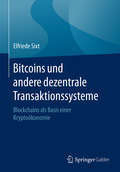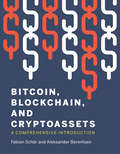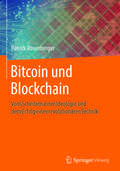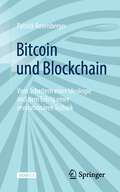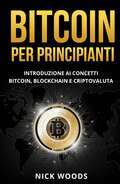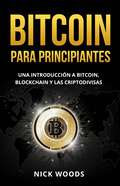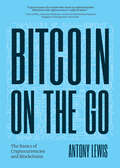- Table View
- List View
BizTalk Server 2010 Cookbook
by Steef-Jan WiggersThis book will explain step-by-step in each recipe how to, for example, implement a certain orchestration pattern, test a BizTalk artifact, monitor BizTalk with a third party tool, or secure a message. The recipes in this book are easy to understand and follow as the author discusses real-world scenarios. The range of topics covered in this book will bring out the forward-thinking BizTalk developer in you. The examples are supported by relevant background information for ease of understanding. This book is for professional BizTalk Developers and administrators to take their skills to the next level and explore the numerous capabilities BizTalk has. This book assumes that you have a basic understanding of BizTalk and SOA and BPM concepts.
BizTalk 2013 Recipes: A Problem-Solution Approach
by Mark Beckner Kishore DharanikotaBizTalk 2013 Recipes provides ready-made solutions to BizTalk Server 2013 developers. The recipes in the book save you the effort of developing your own solutions to common problems that have been solved many times over. The solutions demonstrate sound practice, the result of hard-earned wisdom by those who have gone before. Presented in a step-by-step format with clear code examples and explanations, the solutions in BizTalk 2013 Recipes help you take advantage of new features and deeper capabilities in BizTalk Server 2013. You'll learn to integrate your solutions with the cloud, configure BizTalk on Azure, work with electronic data interchange (EDI), and deploy the growing range of adapters for integrating with the different systems and technologies that you will encounter. You'll find recipes covering all the core areas: schemas, maps, orchestrations, messaging and more. BizTalk Server 2013 is Microsoft's market-leading platform for orchestrating process flow across disparate applications. BizTalk 2013 Recipes is your key to unlocking the full power of that platform. What you'll learn Automate business processes across different systems in your enterprise. Build, test, and deploy complex maps and schemas. Implement the business rules engine (BRE). Develop business activity monitoring (BAM) solutions. Manage electronic data interchange (EDI) with trading partners. Monitor and troubleshoot automated processes. Deploy BizTalk to Azure and build cloud based solutions. Who this book is for BizTalk 2013 Recipes is aimed at developers working in Microsoft BizTalk Server 2013. Experienced BizTalk developers will find great value in the information around new functionality in the 2013 release such as that for cloud based integrations. Those brand new to BizTalk will appreciate the clear examples of core functionality that help them understand how best to design and deploy BizTalk Server solutions. Table of Contents What's New in BizTalk Server 2013 Document Schemas Document Mapping Messaging and Pipelines Orchestrations Adapters Business Rules Framework EDI Solutions Cloud Solutions Deployment Administration and Operations Business Activity Monitoring
BizTalk 2013 EDI for Health Care: HIPAA-Compliant 834 (Enrollment) and 837 (Claims) Solutions
by Mark BecknerBizTalk 2013 EDI for Healthcare - EDI 834Enrollment Solutions eliminates the complexity anddemonstrates how to build both inbound and outbound EDI 834 processes inBizTalk server that follow the required patterns for integrations with theseexchanges. Archiving, mapping,reconstituting EDI 837 data, exception handling and advanced logging andreporting (without the need for BAM!) are all covered in enough detail to allowyou to implement your own fully functional solution. The Affordable CareAct and the requirements to integrate with state Exchanges have securedBizTalk's role with integrations within the healthcare industry. EDI 834 documents are the heart to allintegrations, dealing with enrollment and the maintenance of enrollments. In order to successfully integrate with theexchanges, companies are required to implement a number of architectural componentsthat can be daunting and complex to work through. High-quality resources for IT professional to handle these challenges are sorely needed, and this resource has been designed to provide concise solutions. What you'll learn Learn how to develop complete end to end EDI 834 solutions, both inbound and outbound Create a solution that demonstrates how to integrate with state Exchanges Explore options for custom pipeline components, archiving patterns, lookups Detailed information for advanced 834 EDI mapping Who this book is for BizTalk administrators and developers, as well as management personnel connected with these positions. Table of Contents 1. Architectural Patterns 2. Solution: Receiving 837P Data 3. Solution: Sending 837P Data 4. Mapping Data 5. Adapters, AS2 and Acks 6. Solution: Receiving 834 Data 7. Pipelines for 834 Processing 8. Custom Business Rules 9. Advanced 834 Mapping 10. Solution: Sending 834 Data 11. Solution: Sending 834 Data, Simplified
Bitwise: A Life in Code
by David AuerbachAn exhilarating, elegant memoir and a significant polemic on how computers and algorithms shape our understanding of the world and of who we are Bitwise is a wondrous ode to the computer languages and codes that captured technologist David Auerbach’s imagination. With a philosopher’s sense of inquiry, Auerbach recounts his childhood spent drawing ferns with the programming language Logo on the Apple IIe, his adventures in early text-based video games, his education as an engineer, and his contributions to instant messaging technology developed for Microsoft and the servers powering Google’s data stores. A lifelong student of the systems that shape our lives—from the psychiatric taxonomy of the Diagnostic and Statistical Manual to how Facebook tracks and profiles its users—Auerbach reflects on how he has experienced the algorithms that taxonomize human speech, knowledge, and behavior and that compel us to do the same. Into this exquisitely crafted, wide-ranging memoir of a life spent with code, Auerbach has woven an eye-opening and searing examination of the inescapable ways in which algorithms have both standardized and coarsened our lives. As we engineer ever more intricate technology to translate our experiences and narrow the gap that divides us from the machine, Auerbach argues, we willingly erase our nuances and our idiosyncrasies—precisely the things that make us human.
Bits, Bytes, and Balance Sheets: The New Economic Rules of Engagement in a Wireless World
by Walter B. WristonThis follow-up to the author's Twilight of Sovereignty explores the consequences of the changes produced by the new economy of the Internet, defining the new rules and examining some of the promising initiatives under way to create a system of measuring and valuing assets that reflects our new economic realities. Wriston shows that in today's economy, intellectual capital is more important than physical capital—and that businesses must adapt to this change or perish.
Bits und Bytes in Mikrochips: Grundlagen der Technischen Informatik am Beispiel moderner Hardware
by Klaus BrüderleDieses Lehrbuch bietet einen gut verständlichen Einstieg in die technischen Grundlagen der Informatik, ohne tiefgehende mathematische Vorkenntnisse vorauszusetzen. Dank zahlreicher Übungen und Lösungen eignet sich das Buch hervorragend zum Selbststudium.Neben Grundkenntnissen der Computertechnik werden ebenso die technischen Grundlagen der Industrie 4.0 vermittelt. Ob Sie sich im Studium oder in der Ausbildung befinden, sich für digitale Berufe umqualifizieren möchten oder einfach ein interessierter Laie sind, dieses Buch unterstützt Sie bei Ihrer digitalen Weiterbildung.
Bits und Bytes in Mikrochips: Grundlagen der Technischen Informatik am Beispiel moderner Hardware
by Klaus BrüderleDieses Lehrbuch bietet einen gut verständlichen Einstieg in die technischen Grundlagen der Informatik, ohne tiefgehende mathematische Vorkenntnisse vorauszusetzen. Dank zahlreicher Übungen und Lösungen eignet sich das Buch hervorragend zum Selbststudium. Neben Grundkenntnissen der Computertechnik werden ebenso die technischen Grundlagen der Industrie 4.0 vermittelt. Ob Sie sich im Studium oder in der Ausbildung befinden, sich für digitale Berufe umqualifizieren möchten oder einfach ein interessierter Laie sind, dieses Buch unterstützt Sie bei Ihrer digitalen Weiterbildung. Der Inhalt Zeichen und Bits im Computer: Mensch und Maschine Verbindung der Chips (bis PCIe 7.0 und CXL, bis USB4 2.0 und Thunderbolt 5) Datenträger (HD, PCIe-5.0-SSDs), IOPS, Flash-Technik und Chipsätze bis Intel Serie-700 Arbeitsspeicher bis DDR5, XMP, SO-DIMM, LPDDR-SDRAM, CAMM und Konfiguration des DDR- und LPDDR-SDRAM (Intel, bis Core i-14000(K)) – Zwischenspeicher (Cache) Prozessor-Technologien: Single- und Multithreading, TDP, Power Limits bis 14. CPU-Gen (Raptor Lake Refresh), PWM-Regelung, alles über 12. bis 14. CPU-Generation, Total Hybrid: Chiplets (Tiles), 14. CPU-Mobil-Gen. Core Ultra (Serie 1) Meteor Lake Künstliche Intelligenz: Inferencing, Machine Learning, Datenformate (FP16, BF16 usw.), KI-Rechenwerke der CPU, der GPU und NPU Embedded (Mini PCs usw.) Core Ultra (Hybrid, Serie 1) Elektrischer Strom, Spannung, Leistung, Kondensator usw. Anhang von A (API …) über S (Supercomputer …) bis W (Workstationen) Die Zielgruppen An digitaler Weiterbildung Interessierte Schüler*innen mit dem Fach Informatik Schüler*innen an Berufsfachschulen, Technikerschulen mit Schwerpunkt Informatik und Informatik-Profil-Schulen (IPS) Techniker-Lehrgänge (DAA-Technikum, Fachinformatiker) Studierende der Fächer Informatik, Mechatronik u. a. Der Autor Dipl. Ing. (FH) Klaus Brüderle war Lehrer für Physik und Informatik und verfügt über vier Jahrzehnte Erfahrung in der IT-Bildung.
Bits to Bitcoin: How Our Digital Stuff Works (The\mit Press Ser.)
by Mark Stuart DayAn accessible guide to our digital infrastructure, explaining the basics of operating systems, networks, security, and other topics for the general reader.Most of us feel at home in front of a computer; we own smartphones, tablets, and laptops; we look things up online and check social media to see what our friends are doing. But we may be a bit fuzzy about how any of this really works. In Bits to Bitcoin, Mark Stuart Day offers an accessible guide to our digital infrastructure, explaining the basics of operating systems, networks, security, and related topics for the general reader. He takes the reader from a single process to multiple processes that interact with each other; he explores processes that fail and processes that overcome failures; and he examines processes that attack each other or defend themselves against attacks. Day tells us that steps are digital but ramps are analog; that computation is about “doing something with stuff” and that both the “stuff” and the “doing” can be digital. He explains timesharing, deadlock, and thrashing; virtual memory and virtual machines; packets and networks; resources and servers; secret keys and public keys; Moore's law and Thompson's hack. He describes how building in redundancy guards against failure and how endpoints communicate across the Internet. He explains why programs crash or have other bugs, why they are attacked by viruses, and why those problems are hard to fix. Finally, after examining secrets, trust, and cheating, he explains the mechanisms that allow the Bitcoin system to record money transfers accurately while fending off attacks.
Bits on Chips
by Harry VeendrickThis book provides readers with a broad overview of integrated circuits, also generally referred to as micro-electronics. The presentation is designed to be accessible to readers with limited, technical knowledge and coverage includes key aspects of integrated circuit design, implementation, fabrication and application. The author complements his discussion with a large number of diagrams and photographs, in order to reinforce the explanations. The book is divided into two parts, the first of which is specifically developed for people with almost no or little technical knowledge. It presents an overview of the electronic evolution and discusses the similarity between a chip floor plan and a city plan, using metaphors to help explain concepts. It includes a summary of the chip development cycle, some basic definitions and a variety of applications that use integrated circuits. The second part digs deeper into the details and is perfectly suited for professionals working in one of the semiconductor disciplines who want to broaden their semiconductor horizon.
Bits of Power: Issues in Global Access to Scientific Data
by Committee on Issues in the Transborder Flow of Scientific DataSince Galileo corresponded with Kepler, the community of scientists has become increasingly international. A DNA sequence is as significant to a researcher in Novosibirsk as it is to one in Pasadena. And with the advent of electronic communications technology, these experts can share information within minutes. What are the consequences when more bits of scientific data cross more national borders and do it more swiftly than ever before? Bits of Power assesses the state of international exchange of data in the natural sciences, identifying strengths, weaknesses, and challenges. The committee makes recommendations about access to scientific data derived from public funding. The volume examines: Trends in the electronic transfer and management of scientific data. Pressure toward commercialization of scientific data, including the economic aspects of government dissemination of the data. The implications of proposed changes to intellectual property laws and the role of scientists in shaping legislative and legal solutions. Improving access to scientific data by and from the developing world. Bits of Power explores how these issues have been addressed in the European Community and includes examples of successful data transfer activities in the natural sciences. The book will be of interest to scientists and scientific data managers, as well as intellectual property rights attorneys, legislators, government agencies, and international organizations concerned about the electronic flow of scientific data.
Bite-Size Python: An Introduction to Python Programming
by April SpeightIntroduce children to the popular Python programming language through relatable examples and fun projects! Python has now surpassed Java as the most commonly used programming language. As the language rises in popularity, this complete guide can teach basic Python concepts to kids with its simple, friendly format. Bite-Size Python: An Introduction to Python Programming provides children with a foundation in the Python language. This unique book shares knowledge through easy-to-understand examples, fast exercises, and fun projects! As children learn, their parents, caregivers, and instructors can also join in their discoveries. Bite-Size Python is ideal for those who are new to programming, giving kids ages 9 and up a beginners’ approach to learning one of the most important programming languages. Gives an overview of Python Provides exciting programming projects Offers instruction on how to download and install Python Presents key programming language concepts Simplifies technical definitions With this playful guide to learning Python, readers can try out activities on their computers for a hands-on learning experience. The artwork in Bite-Size Python represents children of various backgrounds, so any child who picks up this book will be empowered to learn and young readers will love showing their projects to friends and family!
Bite Sized Archie: Going Viral (Archie Graphic Novels #2)
by Ron CacaceJust when you thought it was safe to go back on the internet... Why would you ever think that? At least Bite Sized Archie is back in print to take your mind away from that madness.Bite Sized Archie returns in the second collection of the thought-provoking (sure, why not) and satirical (most definitely) webcomic! The gang from Riverdale go way past meta and right into real as they tackle the world of today in their weekly strips. Both charming and sardonic, these comics reflect all the little things in life, pop culture and beyond. Packed with behind-the-scenes content from the creative team, you can't miss this sequel compilation!
Bitcoins und andere dezentrale Transaktionssysteme: Blockchains als Basis einer Kryptoökonomie
by Elfriede SixtDieses Buch beschreibt zum ersten Mal in deutscher Sprache umfassend die verschiedenen digitalen Währungen, das faszinierende Potenzial elektronischen Geldes sowie einer möglichen neuen Wirtschaftsordnung: Geld ist im Bitcoin-System ein programmierbarer Wert, geschützt durch Kryptotechnologien. Experten aus der Finanzbranche arbeiten heute gemeinsam mit Juristen, Wirtschaftsfachleuten und Softwareentwicklern intensiv an neuen kryptographischen Finanzprodukten. Die Erwartungen sind groß: es geht um die Hoffnung auf signifikante Effizienzgewinne und Anwendungsszenarien auf volkswirtschaftlicher und betriebswirtschaftlicher Ebene. Mit den neuen Finanzprodukten und -Dienstleistungen sollen Einzelpersonen, Organisationen und sogar Maschinen Transaktionen flexibler, effizienter und produktiver ausführen. Die Autorin gibt dem Leser einen umfassenden Wegweiser in die komplexe Gegenwart und mögliche Zukunft des Cybergeldes mit seinen Vor- und Nachteilen, Informationen über die praktischen Nutzungsmöglichkeiten, die rechtlichen Implikationen und den Schutz vor seinen Gefahren.
Bitcoin: Uma Introdução Simples
by Eric Morse João Rossi ParreirasA Bitcoin é uma moeda digital revolucionária que está mudando o dinheiro como o conhecemos, mas entendê-la pode ser um pouco assustador para o usuário novato. Não é mais! Este livro se despe de toda a complexidade e ensina o básico da Bitcoin em uma linguagem simples e fácil de entender. Este livro não é um livro didático. Ele é um guia para iniciantes que responde as perguntas mais comuns e importantes que novos usuários têm sobre a Bitcoin. Sem jargões. Sem tecnicalidades. Sem nenhum conhecimento técnico prévio necessário. As respostas que encontrará neste livro: O que é a Bitcoin? O que faz dela especial? O que é a Blockchain? O que é mineração? Quem controla a Bitcoin? A Bitcoin é segura? A Bitcoin é anônima? Como posso utilizar a Bitcoin com segurança? Eu devo investir em Bitcoins? ...E Mais! E você não se sentirá aprendendo um novo idioma ou obtendo um diploma em tecnologia da informação! Pré-requisitos: NENHUM! Se você alguma vez já comprou algo pela internet, você já sabe o necessário para entender este livro e aprender o básico sobre a Bitcoin.
Bitcoin: Introducción simple
by Eric Morse Esteban Lanza OrtegaComprende los fundamentos de Bitcoin. Bitcoin es una revolucionaria divisa digital que está transformando el concepto de dinero que conocemos. Pero su comprensión puede ser intimidante para el usuario medio. ¡A partir de ahora dejará de serlo! Este libro elimina esta complejidad y enseña los fundamentos de Bitcoin de manera simple, con un lenguaje fácil de entender. No es un libro de texto. Es un primer contacto que responde a las más importantes y comunes preguntas que los nuevos usuarios tienen sobre Bitcoin. Sin jerga, sin tecnicismos y sin requerir conocimientos previos. En este libro encontrarás respuestas a preguntas como: ¿Qué es Bitcoin? ¿Qué lo hace tan especial? ¿Qué es el Blockchain? ¿Qué es la minería? ¿Quién controla Bitcoin? ¿Es Bitcoin seguro? ¿Es Bitcoin anónimo? ¿Cómo puedo usarlo de manera segura? ¿Debería invertir en Bitcoin? ¡…Y mucho más! ¡Y con este libro no te sentirás como si te estuvieran enseñando una lengua extranjera o un grado en ciencias de la computación! Prerrequisitos: ¡NINGUNO! Si alguna vez has comprado algo online, ya tienes lo que se necesita para entender este libro y aprender los fundamentos de Bitcoin.
Bitcoin: Een eenvoudige introductie
by Eric Morse Anne Van GulickBitcoin is een revolutionaire digitale valuta die de manier waarop we over geld denken verandert, maar de complexiteit ervan kan ontmoedigend zijn voor de gemiddelde gebruiker. Maar nu niet meer! Dit boek rekent af met de complexiteit en legt de basis van Bitcoin uit in eenvoudige taal. Het is geen lesboek, maar een niet-technische inleiding die de meest voorkomende en belangrijkste vragen die beginnende gebruikers over Bitcoin hebben beantwoordt. Geen jargon, geen technobabble en geen technische voorkennis vereist. De volgende vragen worden beantwoord in het boek: Wat is Bitcoin? Waarom is het zo bijzonder? Wat is de blokketen? Wat is mining? Wie heeft de controle over Bitcoin? Is Bitcoin veilig? Is Bitcoin anoniem? Hoe kan ik Bitcoin veilig gebruiken? Is het een goed idee om te investeren in Bitcoin? ... en meer! Je zult niet het gevoel krijgen dat je een andere taal aan het leren bent of een studie computerwetenschappen aan het doen bent! Vereiste voorkennis: geen! Als je ooit eerder iets online gekocht hebt, weet je alles al wat nodig is om dit boek te begrijpen en de basis van Bitcoin te leren.
Bitcoin, Blockchain, and Cryptoassets: A Comprehensive Introduction
by Fabian Schar Aleksander BerentsenAn introduction to cryptocurrencies and blockchain technology; a guide for practitioners and students.Bitcoin and blockchain enable the ownership of virtual property without the need for a central authority. Additionally, Bitcoin and other cryptocurrencies make up an entirely new class of assets that have the potential for fundamental change in the current financial system. This book offers an introduction to cryptocurrencies and blockchain technology from the perspective of monetary economics.
Bitcoin und Blockchain: Vom Scheitern einer Ideologie und dem Erfolg einer revolutionären Technik
by Patrick RosenbergerDie Einführung von Kryptowährungen und der Blockchain-Technologie stellt unsere Gesellschaft vor völlig neue Herausforderungen. Schon in naher Zukunft werden sämtliche Bestandteile unseres Lebens unter dem Einfluss eines dezentralen Netzwerks stehen. Banken, Unternehmen, sogar Regierungen setzen auf das Potenzial der dezentralen Datenspeicherung. Was aber sind Blockchain und Kryptowährungen und wie sind sie entstanden? Dieses Buch ist eine unverzichtbare Lektüre für alle, die ein tiefes Verständnis für dieses Thema entwickeln möchten, ohne sich dafür mit Formeln oder Programmcode auseinanderzusetzen.Zur Einführung beleuchtet der Autor die Geschichte des Geldes und zeigt, wie sich die Zukunftswährung Bitcoin dank der innovativen Blockchains entwickeln konnte. Der legendäre Erfinder der ersten Kryptowährung, Satoshi Nakamoto, bleibt zwar bis heute anonym, ist jedoch in der Währung, die er sogar mit seinem Namen geprägt hat, mittlerweile millionenschwer. Detailliert beschreibt der Autor die Ideologie hinter der Technologie und ihre zahlreichen Anwendungsmöglichkeiten. Neben den berühmten Bitcoins haben inzwischen auch viele weitere Kryptowährungen wie Ethereum entwickelt, die ebenfalls auf der Technologie der Blockchains basiert. Mit der fortschreitenden Evolution des Internets der Dinge ist noch lange kein Ende der Entwicklung in Sicht. Allerdings entstehen bereits die ersten Alternativen zur Blockchain-Technologie, namentlich in Form des IOTA-Netzwerkes, einer Technik, die seit 2015 entwickelt wird und aktuell in der Betaphase steckt.Mit diesen und vielen weiteren Aspekten liefert das Buch eine spannende Lektüre zu einem der Themen der Zukunft und vermittelt erfahrenen Informatikern, aber auch technikaffinen Laien ein umfassendes Grundlagenwissen über Kryptowährungen und ihre zugrundeliegenden Technologien.
Bitcoin und Blockchain: Vom Scheitern einer Ideologie und dem Erfolg einer revolutionären Technik
by Patrick RosenbergerDer Erfolg von Kryptowährungen und der Blockchain-Technologie stellt unsere Gesellschaft vor völlig neue Herausforderungen. Schon in naher Zukunft könnten sämtliche Bestandteile unseres Lebens unter dem Einfluss eines dezentralen Netzwerks stehen. Banken, Unternehmen, sogar Regierungen setzen auf das Potenzial der dezentralen Datenspeicherung. Mit der fortschreitenden Evolution des Internets der Dinge, dem Metaverse oder der Möglichkeit, Vermögenswerte zu tokenisieren, ist noch lange kein Ende der Entwicklung in Sicht. Dabei war die Idee und Ideologie hinter Bitcoin eigentlich eine ganz andere: Die digitale Währung wurde als ein alternatives Zahlungssystem erfunden, das ohne die Kontrolle von Banken funktioniert.Dieses Buch ist eine unverzichtbare Lektüre für alle, die ein tiefes Verständnis für dieses Thema entwickeln möchten, ohne sich dafür mit Formeln oder Programmcode auseinanderzusetzen.
Bitcoin per tutti
by Eric Morse F. RossiCapire le basi dei Bitcoin I bitcoin sono una valuta digitale rivoluzionaria che sta trasformando il denaro come lo conosciamo, ma capire come funzionano può essere difficoltoso per un utente medio. Ora non più! Questo libro mette da parte le complessità e insegna le basi dei Bitcoin in modo semplice e comprensibile. Non è un libro di testo, ma un manuale introduttivo non tecnico che risponde alle domande più comuni e importanti che gli utenti hanno sui bitcoin, senza usare tecnicismi e senza aver bisogno di conoscenze tecniche pregresse. In questo libro troverete le risposte a: Cosa sono i Bitcoin? Cos’hanno di speciale? Cosa è la Blockchain? Cos’è il Mining? Chi controlla i Bitcoin? I Bitcoin sono sicuri? I Bitcoin sono anonimi? Come posso usarli in sicurezza? Devo investirci? ...e molto altro! E non vi sentirete come se steste imparando un'altra lingua o studiando per una laurea in informatica! Prerequisiti: NESSUNO! Se avete comprato qualcosa online sapete tutto ciò che serve per capire questo libro e imparare le basi di Bitcoin.
Bitcoin per Principianti: Un’introduzione al Bitcoin, Blockchain e Criptovalute
by Nick WoodsState cercando di imparare come poter guadagnare dalla rivoluzione del Bitcoin? Avete sentito parlare di Bitcoin ultimamente e non riuscite a capire cosa sia? Vi chiedete come potete iniziare a investire in Bitcoin, ma siete esitanti nell'investire in qualcosa che non capite? Vorreste essere in grado di capire il Bitcoin, ma avete paura che sia troppo complesso e complicato? State cercando una risorsa che vi aiuti a capire il Bitcoin, in modo da poter iniziare a investire in criptovalute senza paura? Se questo è il vostro caso, allora continuate a leggere! Bitcoin è un'affascinante valuta decentralizzata della nuova era che è disponibile solo online e permette all'utente di essere anonimo. È una moneta digitale che può essere utilizzata da chiunque sia collegato a Internet ed è indipendente da qualsiasi regione. Potete conservare iBitcoin in un "portafoglio elettronico", proprio come mettete i vostri soldi nel vostro portafoglio o in una banca. Tutto questo è gestito elettronicamente e non c'è denaro fiat (carta) coinvolto. Capire Bitcoin vi aiuterà a raggiungere tutti i vostri obiettivi investendo nella criptovaluta, non importa quanto grandi o piccoli siano. Indipendentemente da chi siete e da cosa volete realizzare, la base del Bitcoin è la stessa per tutti. Questo libro vi aiuterà a capire tutto quello che dovete sapere su Bitcoin, Blockchain e criptovalute, compresi i benefici e le sfide della nuova tecnologia. Vi fornirò una guida passo dopo passo per raggiungere un livello superiore di comprensione in modo che voi possiate sentirvi a vostro agio nell'essere coinvolto con Bitcoin e altre criptovalute. Non c'è mai stato un libro così facile nel suo approccio e così efficace per capire Bitcoin da un livello principiante. All'interno di queste pagine, scoprirete: Cos'è Bitcoin in dettaglio Perché Bitcoin è importante Confronto di Bitcoin con le valute Fiat<br
Bitcoin para principiantes
by Emmanuel ClementsBITCOIN PARA PRINCIPIANTES: La guía completa para principiantes para aprender, entender y explorar el mundo de Bitcoin en 2019 - Entender el poder de la tecnología de criptocurrency. Bitcoin es una criptocurrency creada en 2009. Los mercados denominados "bolsas de monedas" permiten a la gente comprar o vender monedas con diferentes monedas. Bitcoin es una nueva moneda que fue creada en 2009 por un desconocido con el alias de Satoshi Nakamoto. Las transacciones se realizan sin intermediarios, es decir, sin bancos. Bitcoin se puede utilizar para reservar hoteles en Expedia, comprar muebles en Overstock y comprar juegos de Xbox. Pero gran parte del bombo se trata de enriquecerse con el comercio. El precio del bitcoin se disparó a miles en 2017.
Bitcoin para Principiantes: Una Introducción a Bitcoin, Blockchain y las Criptodivisas
by Nick WoodsBitcoin es una fascinante divisa descentralizada new-age que sólo está disponible en línea y permite al usuario permanecer casi anónimo. Es una moneda digital que puede ser usada por cualquiera con conexión a Internet y de manera independiente a la región. Se pueden almacenar Bitcoins en una "billetera electrónica" de manera similar a como se hace en una billetera física o en un banco. Todo esto se hace de manera electrónica y no hay dinero (papel) fiduciario involucrado. Este libro te ayudará a entender todo lo que necesitas sobre Bitcoin, blockchain y las criptodivisas, incluyendo los beneficios y retos de la nueva tecnología, y te proveeré con una guía paso a paso para alcanzar altos niveles de entendimiento para que te puedas sentir cómodo al involucrarte con Bitcoin y otras criptodivisas.
Bitcoin para Iniciantes: Uma Introdução aos Conceitos de Bitcoin, Blockchain e Criptomoeda
by Nick WoodsBitcoin para Iniciantes por Nick Woods Uma introdução aos conceitos de Bitcoin, Blockchain e Criptomoeda Bitcoin é uma fascinante moeda descenteralizada da nova era que só se encontra disponível online e permite que o usuário se mantenha um tanto quanto anônimo. É uma moeda digital que pode ser usada por qualquer pessoa conectada à Internet e é independente de qualquer região. Você mantém o Bitcoin em uma "carteira eletrônica", da mesma forma que coloca seu dinheiro na carteira de couro ou no banco. Tudo isso é operado eletronicamente e não há moeda fiat (papel) envolvida. Este livro irá ajudá-lo(a) a entender tudo o que você precisa saber sobre Bitcoin, Blockchain e Criptomoedas, incluindo os benefícios e desafios da nova tecnologia, e eu irei fornecer a você um guia passo a passo para alcançar um nível mais alto de compreensão para que possa se sentir confortável ao se envolver com o Bitcoin e outras criptomoedas.
Bitcoin on the Go: The Basics of Bitcoins and Blockchains
by Antony LewisA Condensed Guide to Understanding Bitcoin, Blockchains, and Cryptocurrency“One of the few credible books I suggest when people ask ‘where can I learn about bitcoin?’―Zennon Kapron, Managing Director, Kapronasia (Review of The Basics of Bitcoins and Blockchains)You’re an active, on-the-go person and need a condensed version of the Antony Lewis best-selling The Basics of Bitcoins and Blockchains? Now Bitcoin on the Go offers the same clear guide to this new currency and the revolutionary technology that powers it―just in a condensed format.Bitcoin, Ethereum, and other cryptocurrencies. Gain an understanding of a broad spectrum of Bitcoin topics including the history of Bitcoin, the Bitcoin blockchain, and Bitcoin buying, selling, and mining. Learn how payments are made, and how to put a value on cryptocurrencies and digital tokens.Blockchain technology. What exactly is a blockchain, how does it work, and why is it important? Bitcoin on the Go answers these questions and more. Learn about notable blockchain platforms, smart contracts, and other important facets of blockchains and their function in the changing cyber-economy.Things to know before buying cryptocurrencies. Find trustworthy and balanced insights into Bitcoin investing and investing in other cryptocurrencies. Discover the risks and mitigations, learn how to identify scams, and understand cryptocurrency exchanges, digital wallets, and regulations.Learn about:Blockchain technology and how it worksWorkings of the cryptocurrency marketEvolution and potential impacts of Bitcoin and blockchains on global businessesYou’ve read The Bitcoin Standard, Blockchain Bubble or Revolution, the full version of The Basics of Bitcoins and Blockchains by Antony Lewis, or The Only Cryptocurrency Investing Book You'll Ever Need but you want to understand this new currency in a quick easy-to-read format. Pick up a copy of Bitcoin on the Go.
